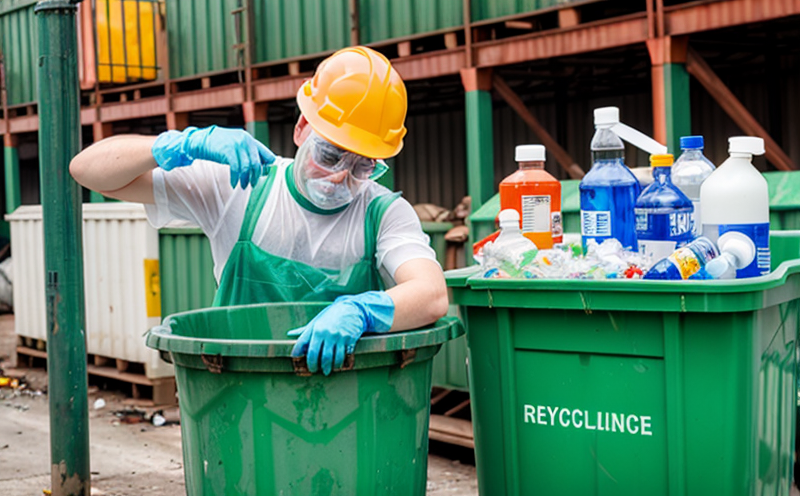JIS K0805 VOC Testing in Waste Streams
The Japanese Industrial Standard (JIS) K0805 test method is a stringent procedure for determining volatile organic compounds (VOCs) in waste streams, ensuring compliance with environmental regulations and quality control standards.
Environmental pollution from industrial waste streams can have significant impacts on air quality, water resources, and human health. VOCs are one of the primary pollutants that need to be monitored closely during waste management processes. The JIS K0805 test method is a key tool for quantifying these compounds in complex matrices such as municipal solid waste, hazardous waste, and industrial effluents.
The procedure involves several critical steps including sample collection, pre-treatment, extraction of VOCs using solvent methods or thermal desorption, and measurement by gas chromatography. The test method is designed to ensure accurate detection down to very low concentrations, which is essential for effective waste management practices that adhere to environmental legislation.
The JIS K0805 standard specifies the use of specific solvents such as dichloromethane (DCM) or hexane for extraction based on the boiling point and volatility characteristics of the VOCs present. The extracted compounds are then analyzed using gas chromatography equipped with mass spectrometry detection, which provides high sensitivity and selectivity needed to identify even trace amounts of VOCs.
The significance of this test method lies in its ability to provide precise quantification data that can be used for both regulatory compliance and internal quality assurance purposes. For instance, the results from JIS K0805 testing help determine if waste streams meet specific discharge limits set by environmental authorities or company-specific standards.
Furthermore, understanding VOC levels in waste is crucial for proper disposal planning and recycling initiatives. By knowing exactly what types of VOCs are present at various concentrations, industries can make informed decisions about how best to handle these wastes – whether through incineration, landfilling, or more environmentally friendly treatment processes like composting or anaerobic digestion.
- VOCs identified by JIS K0805 testing include aliphatic hydrocarbons (e.g., methane), aromatic hydrocarbons (e.g., benzene), and halogenated compounds (e.g., trichloroethylene).
- The test method ensures accurate quantification of VOC concentrations, typically measured in parts per million (ppm) or micrograms per liter (µg/L).
- Compliance with JIS K0805 standards is mandatory for industries involved in waste management and recycling operations.
Eurolab Advantages
Eurolab offers unparalleled expertise in executing the JIS K0805 VOC testing method, providing accurate results that are essential for effective waste management and recycling programs. Our experienced team ensures compliance with international standards while offering customized solutions tailored to specific client needs.
Our advanced laboratory facilities equipped with state-of-the-art analytical instruments guarantee precise measurements down to the lowest detectable levels of VOCs. This precision is critical when dealing with complex matrices like waste streams, which may contain numerous compounds in varying concentrations. Our methodology ensures consistent and reliable results across multiple samples.
At Eurolab, we pride ourselves on delivering not just accurate test outcomes but also comprehensive reports that offer detailed insights into the nature and concentration of VOCs present in each sample analyzed. This information is invaluable for clients looking to optimize their waste management strategies or improve recycling processes.
In addition to technical excellence, Eurolab provides exceptional customer service, ensuring timely delivery of results and clear communication throughout the testing process. We understand that accurate data on VOC levels can impact business decisions significantly; hence we strive to provide rapid turnaround times without compromising quality.
Why Choose This Test
The JIS K0805 test is vital for several reasons, especially in the context of waste management and recycling. Firstly, it helps ensure that industrial emissions meet strict environmental standards set by regulatory bodies like Japan’s Ministry of Environment.
Secondly, understanding VOC levels within waste streams allows organizations to implement more efficient disposal methods or explore opportunities for resource recovery through recycling initiatives. By knowing precisely what types of VOCs are present and their concentrations, companies can better assess the risks associated with each type of waste material.
Moreover, compliance with JIS K0805 standards is increasingly becoming a key factor in gaining market access to countries like Japan where stringent environmental regulations apply. Companies that demonstrate robust monitoring practices aligned with these standards are likely to gain competitive advantages over those who do not.
The test also plays an important role in reducing emissions from landfills by identifying potentially harmful VOCs early on during the waste stream lifecycle, allowing for targeted interventions aimed at minimizing environmental impact.





